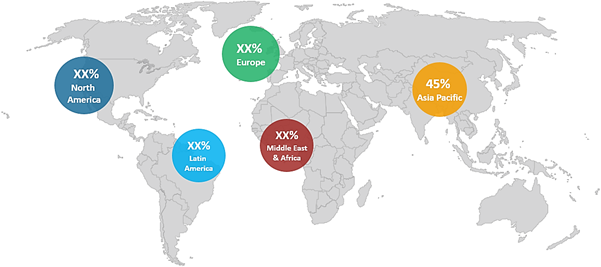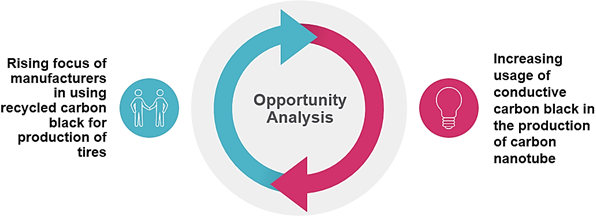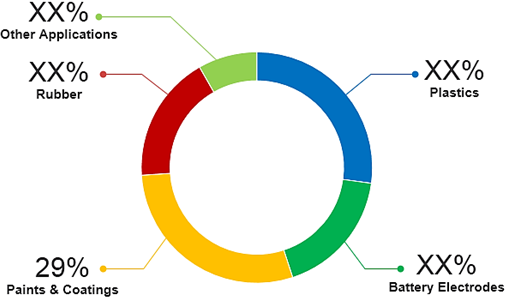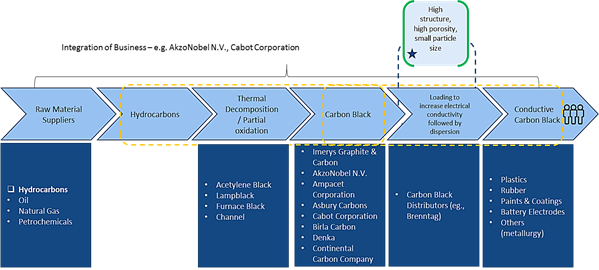Carbon black is a pure form of carbon and is one of the most versatile chemicals produced around the globe. It is mainly find application in the production of rubber where it is used as a reinforcing agent. Moreover, carbon black is also used across plastics, paints & coatings, pigments, printing inks for electrical conductivity, etc. Carbon black improves the physical properties of polymers such as tensile strength, durability, and resistance to abrasion, corrosion, and friction. Carbon black enable conductive network when blend with the polymer matrix. Conductive carbon black also find application in the electronics industry as it enhances electrical conductivity of the appliances.
The global conductive carbon black market is projected to surpass US$ 1,113 million by the end of 2030, in terms of revenue, growing at CAGR of 7.4% during the forecast period (2023 to 2030).
Drivers
Rising demand for consumer electronics where conductive carbon black is used to enhance the electrical conductivity is expected to propel market growth. According to, Indian Brand Equity Foundation (IBEF), the Indian appliance and consumer electronics industry reached US$ 31.48 billion in 2017 and is expected to increase at a 9% CAGR to reach US$ 48.37 billion in 2022.
Growing demand for conductive carbon black from the automotive industry in the production of the tire and other accessories composed of rubber is anticipated to foster the market growth of conductive carbon black. According to the report published by European Automobile Manufacturers Association (ACEA) in June 2019, 98.1 million motor vehicles were produced around the world in 2018 and More than 80 million passenger cars were produced around the world in 2017. Therefore, rising demand from the automotive industry is expected to propel the market growth of Conductive carbon black.
Regionally, Asia-pacific dominated the global conductive carbon black market in 2022, reporting 45% market share in terms of revenue, followed by North America and Europe, respectively.
Figure 1. Global Conductive Carbon Black Market, Revenue Share (%), By Region

To learn more about this report, Request sample copy
Market Restraints
Factor such as toxicity associated with conductive carbon blacks as they have potential carcinogens properties is expected to hinder the market growth over the forecast period. The prolonged exposure of conductive black carbon cause irritation to the respiratory tract. Hence, such side-effects associated with the exposure of conductive carbon blacks are projected to restrict the market growth over the forecast period.
Availability of alternatives of carbon black such as silica and silicones as they have high performance and are environment-friendly in nature is projected to curb the market growth of conductive carbon blacks. Moreover, the market for conductive carbon black is also expected to face competition with other alternatives. For instance, bio-based lignin is a potential substitute to fossil-fuel derived conductive carbon black. Ball milled lignin exhibited a surface area 882% larger than conductive carbon black tested, and 36% greater conductivity.
Market Opportunities
Rising focus of manufacturers in carbon black recovery for tire production is expected to augment the market growth of conductive carbon black. The objective of this step is to explore affordable methods to recover and reuse carbon black in order to promote sustainability. According to the Coherent Market Insights, tire recycling company Carbon Green Inc. has been researching tire recycling methods based on pyrolysis
Rising production of carbon nanotubes with conductive carbon black is expected to accelerate the market growth of carbon black recovery. This combination offers higher electrode conductivity as compared to other formulations since it enables the dispersion of carbon nanotubes and generate a synergetic effect with carbon nanotubes. Therefore, the growing usage of conductive carbon black in the production of carbon nanotube is expected to propel the market growth.
Figure 2. Global Conductive Carbon Black Market – Opportunity Analysis

To learn more about this report, Request sample copy
Market Trends
Shifting focus of carbon black companies to convert their carbon black production lines to specialty carbon blacks is expected to foster market growth. The objective of the step is to increase profit margins and expand the application scope of specialty carbon blacks. For instance, in February 2017, Orion Engineered Carbons launched new specialty carbon black production line in Korea. This new line in Yeosu will produce premium grades of Specialty Carbon Black for demanding customer applications such as automotive coatings, engineered plastics, printing inks, and adhesives & sealants.
The increasing focus of key industry players in emerging countries such as Brazil, China, India, and Korea to set up production facilities is projected to foster market growth. The goal of this step is to take advantage through alliances with key players in the domestic market and expand their regional presence and also reduces transportation costs of carbon black. This factor is estimated to propel the market growth.
Figure 3. Global Conductive Carbon Black Market, Revenue Share (%), By Application

To learn more about this report, Request sample copy
On the basis of applications, in 2018, paints & coatings segment accounted the largest market share of 29% in terms of revenue, followed by plastics and battery electrodes, respectively
Figure 4. Global Conductive Carbon Black Market – Value Chain Analysis

To learn more about this report, Request sample copy
Competitive Section
Key players operating in the global conductive carbon black AkzoNobel N.V., Orion Engineered Carbons, Cabot Corporation, Denka Company Limited, Tokai Carbon Co. Ltd, and Phillips Carbon Black Limited
Few Recent Developments
Cabot Corporation
Share
Share
About Author
Yash Doshi is a Senior Management Consultant. He has 12+ years of experience in conducting research and handling consulting projects across verticals in APAC, EMEA, and the Americas.
He brings strong acumen in helping chemical companies navigate complex challenges and identify growth opportunities. He has deep expertise across the chemicals value chain, including commodity, specialty and fine chemicals, plastics and polymers, and petrochemicals. Yash is a sought-after speaker at industry conferences and contributes to various publications on topics related commodity, specialty and fine chemicals, plastics and polymers, and petrochemicals.
Missing comfort of reading report in your local language? Find your preferred language :
Transform your Strategy with Exclusive Trending Reports :
Frequently Asked Questions
Select a License Type
Credibility and Certifications

860519526

9001:2015
27001:2022


Joining thousands of companies around the world committed to making the Excellent Business Solutions.
View All Our Clients
US Reciprocal Tax Impact Analysis On Conductive Carbon Black Market
Stay updated on tariff changes with expert insights and timely information